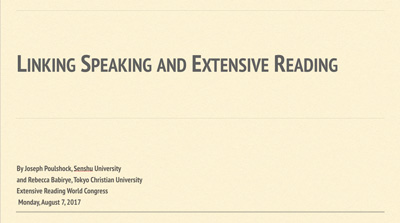By Joseph Poulshock and Rebecca Babirye
A paper presented at the Extensive Reading World Congress
Monday, August 7, 2017
Teachers can show how reading can help students improve speaking by linking reading and speaking activities. One such linked activity is the problem solver. Presenters will show how to make problem solvers linked to readings and provide a simple recipe and downloadable template for generating many problem solvers.
 Learners often measure their English ability by how well they speak, not by how well they read. However, teachers can link reading and speaking activities, showing students how reading relates to speaking.
Learners often measure their English ability by how well they speak, not by how well they read. However, teachers can link reading and speaking activities, showing students how reading relates to speaking.
One such activity is called the problem solver (Nation, 2013). Problem solvers are small-group speaking activities, which employ three concrete outcomes. The three basic outcomes for problem solvers are: suggest, choose, and rank, and teachers can link these outcomes to extensive, fluency, or intensive reading.
For example, the teacher assigns a simple biography of a famous musician. Students may read it as homework or in-class. After students understand the story, they break into groups and do a problem solver directly or indirectly linked to the story.
Teachers can instruct students as follows. Step one and problem: You want to share your favorite music with friends. As a group, *suggest* 5-7 artists or bands in a list that your friends will like. Step 2: Individual members *choose* your favorite of the five and give a reason for your choice. Step 3: As a group, *rank* your suggestions where number one is the best. Step 4: Groups share their rankings with the class.
This is a sure-fire speaking activity linked to a reading. The three concrete outcomes ensure that it works, by providing a clear recipe for discussion. Presenters will explain other types of problem solvers and provide a basic downloadable template for teachers to create their own.
Reference
Nation, P. (2013). What Should Every EFL Teacher Know? Compass Publishing.
